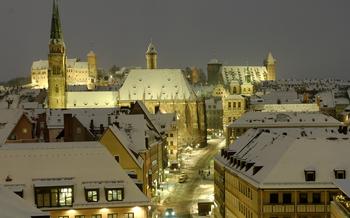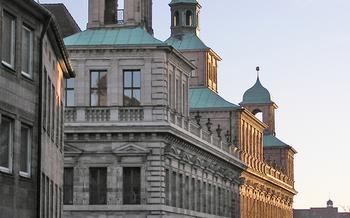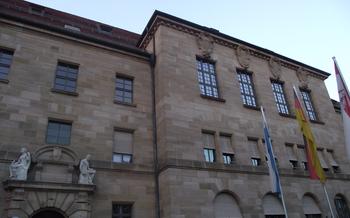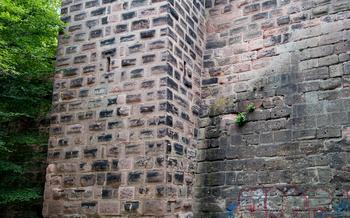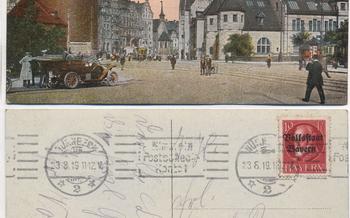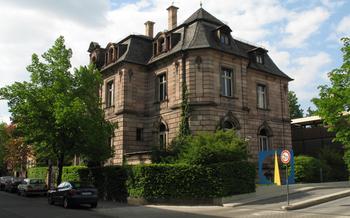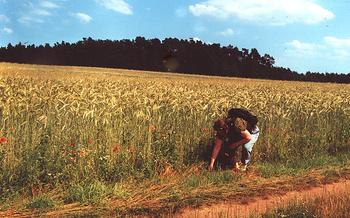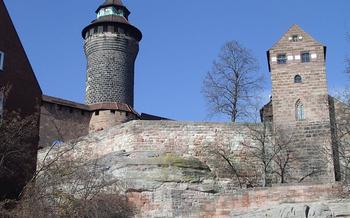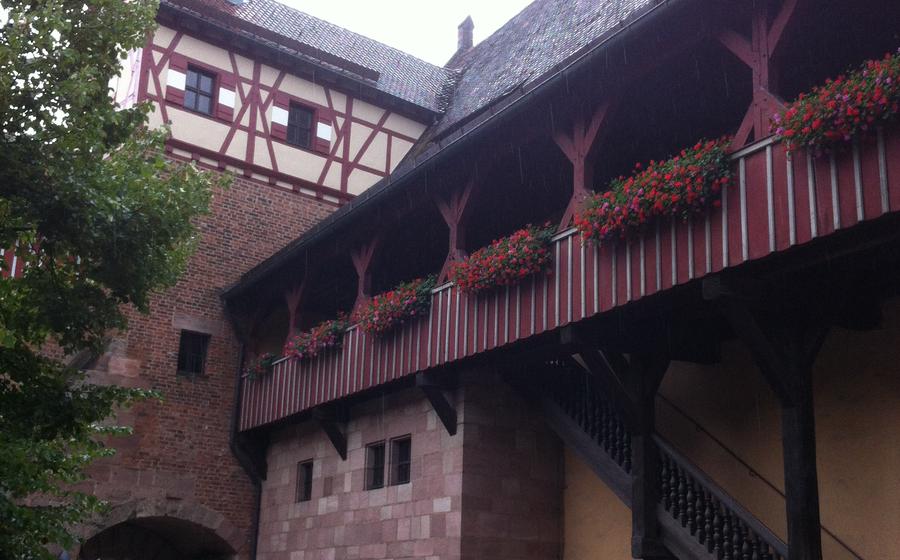
Lochgefängnisse (Medieval Dungeons)
- The Dark Side of Nuremberg
- A Journey Through Time
- Exploring the Depths
- The Nuremberg Trials
- The Path to Redemption
- A Place of Reflection
- Practical Information
- Audio Guides and Multimedia
- Educational Programs: Learning from the Past
- Nearby Attractions
- Insider Tip: Unveiling the Secrets of the Lochgefängnisse
The Dark Side of Nuremberg
In the heart of Nuremberg, a city renowned for its medieval charm and historical significance, lies a chilling reminder of its dark past—the Lochgefängnisse, or the Medieval Dungeons. These subterranean chambers, carved deep beneath the city's streets, once served as a place of confinement, torture, and execution, bearing witness to the harsh realities of medieval justice.
During the Middle Ages, Nuremberg emerged as a prominent trading center and a hub of cultural and intellectual exchange. However, beneath its prosperous façade, a sinister undercurrent of crime and social unrest prevailed. The Lochgefängnisse, constructed in the 14th century, became a symbol of the city's relentless pursuit of maintaining order and upholding its laws.
Individuals accused of various offenses, from petty theft to heinous crimes, were thrown into these dank and unforgiving dungeons. The charges against them ranged from disrupting the peace to challenging the authority of the city council. Once incarcerated within the Lochgefängnisse, their fates were sealed, and their lives were subjected to unimaginable suffering.
A Journey Through Time
The Lochgefängnisse's architectural design is a testament to its purpose as a place of confinement and punishment. The dungeons are divided into several sections, each serving a specific function. The upper levels housed the cells, where prisoners were held in cramped and unsanitary conditions. Deeper down, there were torture chambers, where prisoners underwent horrific ordeals to extract confessions or information. The lowest level was reserved for the execution room, where condemned prisoners met their grim fate.
The atmosphere within the Lochgefängnisse is heavy with the weight of history and the suffering that took place within its walls. The cold, damp air and the eerie silence create a sense of unease and claustrophobia. The walls are lined with graffiti left by prisoners, desperate messages and pleas for help that add to the haunting ambiance.
As you explore the Lochgefängnisse, you'll be transported back in time to a period of darkness and despair. The dungeons are a stark reminder of Nuremberg's dark history, a history that should never be forgotten.
Exploring the Depths
The Lochgefängnisse offers guided tours led by knowledgeable and passionate guides who bring the history of the dungeons to life. These tours take visitors on a journey through time, allowing them to step back centuries and experience the dungeons as they were in their grim past. Interactive exhibits and multimedia presentations further enhance the visitor experience, providing additional context and insights into the lives of the prisoners and the trials they endured. Through these guided tours and interactive displays, visitors have the opportunity to immerse themselves in the history of the Lochgefängnisse and gain a deeper understanding of the suffering and injustices that took place within its walls.
The Nuremberg Trials
In the aftermath of World War II, Nuremberg became the stage for a series of pivotal trials that would forever shape the course of international law and human rights. The Nuremberg Trials, held between 1945 and 1949, brought to justice some of the most notorious Nazi war criminals, including Hermann Göring, Rudolf Hess, and Albert Speer. The trials were a groundbreaking moment in history, as they established the principle of individual accountability for crimes against humanity and war crimes.
The Lochgefängnisse played a significant role in the Nuremberg Trials, serving as a temporary holding facility for some of the defendants. The trials were held in a specially constructed courtroom within the Palace of Justice, just a stone's throw away from the dungeons. This proximity added a somber and symbolic dimension to the proceedings, as the trials confronted the perpetrators of some of the most heinous crimes in human history with the very place where so much suffering had occurred.
The legacy of the Nuremberg Trials is immense. They set a precedent for the prosecution of war criminals and laid the foundation for the development of international criminal law. The trials also helped to raise awareness of the atrocities committed during the Holocaust and other Nazi crimes, and they contributed to the process of denazification and reconciliation in Germany.
The Path to Redemption
The Lochgefängnisse's dark legacy has been transformed into a site of remembrance and education. The Nuremberg Documentation Center, established in 1979, aims to document and raise awareness of the city's past, with a focus on the Nazi era and the Nuremberg Trials. Through exhibitions, events, and educational programs, the center seeks to promote reflection, understanding, and reconciliation.
The transformation of the Lochgefängnisse from a place of darkness and suffering to a place of remembrance and education is a powerful reminder of the importance of confronting and learning from history. It serves as a warning against the dangers of intolerance, oppression, and human rights violations, and inspires visitors to work towards a more just and peaceful world.
By visiting the Lochgefängnisse and the Nuremberg Documentation Center, visitors can gain a deeper understanding of the city's complex history and the lessons that can be learned from it. It is a place where the past is remembered, victims are honored, and the fight against all forms of oppression and human rights violations continues.
A Place of Reflection
Visiting the Lochgefängnisse is a profound and emotionally charged experience that leaves a lasting impact on visitors. As you walk through the dark and narrow corridors, you cannot help but feel a sense of heaviness and sorrow as you contemplate the suffering and injustices that took place within these walls. The stories of individual prisoners, the accounts of torture and executions, and the sheer brutality of the medieval justice system are deeply disturbing and thought-provoking.
The Lochgefängnisse serves as a powerful reminder of the dark side of human nature and the importance of remembering the victims of oppression. It is a place where you can reflect on the fragility of human rights and the need to fight against all forms of tyranny and injustice. The dungeons stand as a testament to the resilience of the human spirit and the ability to overcome adversity even in the face of unimaginable suffering.
Your visit to the Lochgefängnisse will undoubtedly leave you with a heavy heart but also with a renewed sense of hope and determination. It is a place that challenges you to confront the past, learn from history, and work towards a better future where human rights are respected, and atrocities like these never happen again.
Practical Information
The Lochgefängnisse, located at Rathausplatz 2-6 in Nuremberg, Germany, are open to the public for guided tours. Guided tours, in both English and German, are available several times a day, providing an immersive and informative experience.
To plan your visit, please check the official website of the Nuremberg Documentation Center for the most up-to-date information on opening hours, admission fees, and tour schedules. It is recommended to book your tour in advance, especially during peak tourist season, to avoid disappointment and secure your spot.
The Lochgefängnisse are wheelchair accessible, with elevators and ramps installed to ensure that all visitors can fully experience the site.
To make the most of your visit, consider arriving a little early to explore the surrounding area and soak in the historic atmosphere. The Old Town of Nuremberg is filled with charming streets, medieval architecture, and lively squares, offering a glimpse into the city's rich past.
Audio Guides and Multimedia
To enhance the visitor's experience, audio guides are available in multiple languages, providing insightful commentary and historical context as you explore the Lochgefängnisse. These guides bring the dungeons' stories to life, allowing you to delve deeper into the lives of the prisoners and the events that transpired within these walls.
Interactive multimedia exhibits further immerse visitors in the history of the Lochgefängnisse. These exhibits use cutting-edge technology to create a multi-sensory experience, combining visual, auditory, and interactive elements. Through these exhibits, you can gain a deeper understanding of the dungeons' architecture, the trials and tribulations of the prisoners, and the significance of the site in Nuremberg's history.
For a truly immersive experience, virtual reality (VR) technology transports visitors back in time, allowing them to experience the Lochgefängnisse as they were centuries ago. Through VR, you can step into the shoes of a prisoner, wander through the dark corridors, and witness the harsh conditions they endured. This innovative technology brings the past to life in a way that is both educational and emotionally impactful.
Educational Programs: Learning from the Past
The Nuremberg Documentation Center offers a range of educational programs and workshops designed to engage students and groups in the history of the Lochgefängnisse, the Nuremberg Trials, and human rights issues. These programs provide an opportunity for participants to delve deeper into the complexities of the past and explore the lessons that can be learned from these dark chapters in history.
Through interactive activities, discussions, and presentations, students can gain a comprehensive understanding of the events that unfolded within the Lochgefängnisse and their broader historical context. They will learn about the legal and ethical implications of the Nuremberg Trials and their impact on international law and human rights.
The center's educational programs emphasize the importance of remembering the victims of oppression and injustice, while also promoting reconciliation and understanding. By fostering critical thinking and encouraging dialogue, the center aims to empower future generations to stand up against human rights violations and work towards a more just and equitable world.
Nearby Attractions
Beyond the Lochgefängnisse, Nuremberg offers a wealth of historical and cultural attractions that invite exploration. Immerse yourself in the city's rich past at the Imperial Castle, a majestic fortress that once served as the residence of the Holy Roman Emperors. Delve into the fascinating world of art and history at the Germanic National Museum, home to an extensive collection spanning from the Middle Ages to the present day.
Stroll through the charming streets of Nuremberg's Old Town, a vibrant tapestry of medieval architecture, colorful facades, and lively squares. Discover the Albrecht Dürer House, where the renowned Renaissance artist lived and worked, and admire his masterpieces at the Albrecht Dürer Museum.
Indulge in the local culinary scene at one of the many traditional Franconian restaurants, savoring hearty dishes like Schäufele (roast pork shoulder) and Nürnberger Rostbratwürste (grilled Nuremberg sausages). Immerse yourself in the lively atmosphere of the Hauptmarkt, the city's central square, where you can browse local markets, admire the Gothic beauty of the Frauenkirche (Church of Our Lady), and soak up the vibrant energy of this historic city.
Insider Tip: Unveiling the Secrets of the Lochgefängnisse
To truly immerse yourself in the haunting history of the Lochgefängnisse and escape the throngs of visitors, plan your visit during the tranquil off-season or on a weekday. This will allow you to wander through the dimly lit corridors and explore the depths of the dungeons at your own pace, without the distraction of crowds. As you delve deeper into the various sections, take the time to carefully read the informative panels that accompany each exhibit. These panels provide invaluable insights into the stories of the prisoners and the chilling events that transpired within these walls, enriching your understanding of Nuremberg's dark past. Be prepared for a profound and emotionally charged experience as you confront the grim realities of the Lochgefängnisse and the human suffering that unfolded within its confines. This journey through time will leave an enduring mark on your soul, reminding you of the importance of remembering and learning from the mistakes of the past to prevent such atrocities from occurring again.
